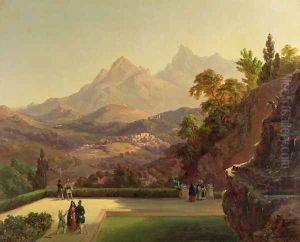(attr.to) Gurlitt, Ludwig (Louis) Paintings
Ludwig (Louis) Gurlitt, born on March 8, 1855, in Nischwitz, Thallwitz, near Leipzig, Germany, was a notable German landscape painter and art collector, who left a significant mark on the art world of the 19th and early 20th centuries. He was part of the Gurlitt family, which had significant contributions to art history, music, and literature. His education in art began at the Grand Ducal Saxon Art School in Weimar, where he was influenced by the Barbizon school and the works of the French impressionists, which is evident in his landscape paintings that are known for their vibrant colors and innovative use of light.
Gurlitt's career as an artist saw him traveling extensively throughout Europe, capturing the essence of the landscapes he visited. His travels took him to the Netherlands, France, Italy, and Norway, among other places, where he painted en plein air, a practice that allowed him to capture the transient effects of light and atmosphere, making his landscapes highly sought after. His work was characterized by a delicate sensibility to nature and an ability to depict it in a way that was both realistic and emotionally evocative.
Beyond his achievements in painting, Gurlitt was also involved in the art world as a collector and dealer, a role that would later see his family name associated with one of the most significant art restitution stories of the 21st century. However, during his lifetime, Ludwig Gurlitt was primarily celebrated for his contributions to landscape painting. His works were exhibited widely, including at the prestigious Berlin Salon, and he was a member of various artists' associations, which played a crucial role in the development of German art at the time.
Gurlitt's legacy is also marked by his role as an educator. He was a respected teacher, imparting his knowledge and passion for art to a new generation of artists. His influence extended beyond his immediate circle, as he was involved in promoting the arts and supporting cultural initiatives in Germany. Ludwig Gurlitt passed away on November 1, 1931, in Berlin, but his work continues to be celebrated for its contribution to the landscape genre and its influence on the development of modern art. His paintings are held in numerous public and private collections, serving as a testament to his skill and vision as an artist.
